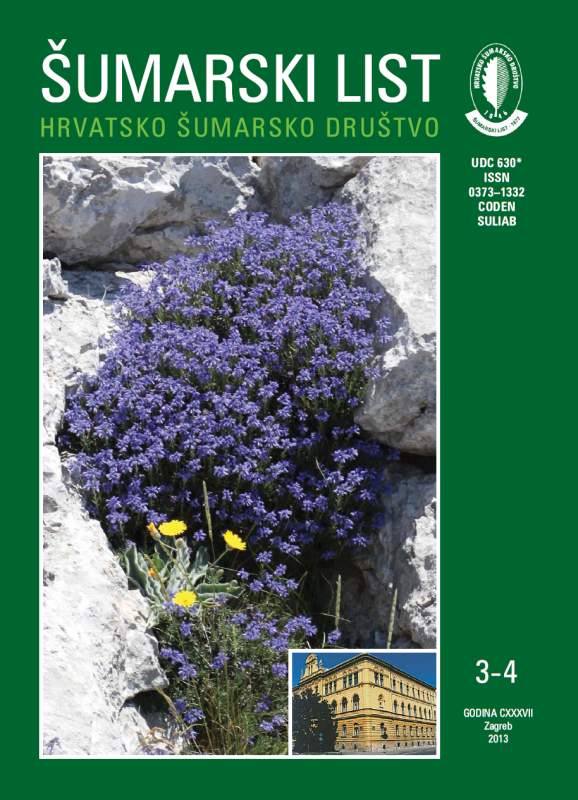
broj: 3-4/2013
pdf (7,8 MB) |
|
||||||||||||||
| RIJEČ UREDNIŠTVA | ||
| Uredništvo | ||
| WHERE DID POLITICALLY BASED PERSONNEL RECRUITMENT AND NON-MARKET MANAGEMENT LEAD US pdf HR EN | 133 | |
| IZVORNI ZNANSTVENI ČLANCI | ||
| Andrej Rozman, Alen Vajdetič, Jurij Diaci | UDK 630*234 (Abies alba Mill.) (001) | |
| A PROTECTED SILVER FIR (Abies alba Mill.) STAND IN SECONDARY SUCCESSION ON A FORMER PASTURE IN POLJANSKA DOLINA, SLOVENIA pdf HR EN | 135 | |
| Drago BRUMEC, Črtomir ROZMAN, Marjan JANŽEKOVIČ, Jernej TURK, Štefan ČELAN | UDK 630*10+156 (001) | |
| AN ASSESSMENT OF DIFFERENT SCENARIOS FOR AGROFORESTRY ENVIRONMENT REGULATION OF DEGRADED LAND USING INTEGRATED SIMULATION AND A MULTI-CRITERIA DECISION MODEL – A CASE STUDY pdf HR EN | 147 | |
| Athanasios STAMPOULIDIS, Elias MILIOS*, Kyriaki KITIKIDOU | UDK 630*23 (Juniperus excelsea M. Bieb.) (001) | |
| THE REGENERATION OF PURE Juniperus excelsa M. Bieb. STANDS IN PRESPA NATIONAL PARK IN GREECE pdf HR EN | 163 | |
| Abstract: Juniperus excelsa M. Bieb is a species with growth plasticity that is capable of growing in harsh abiotic environments as well as in severe biotic conditions. In order to analyze the regeneration of J. excelsa pure stands in Prespa National Park of Greece and to determine whether regeneration in gaps or under facilitation of nurse plants dominates, ninety sample plots were established in two site types and six structural types. In each plot, all J. excelsa regeneration plants were graded in 2 categories. The first category represents the seedlings that have been established and grew under the facilitation of other plants, while the second category refers to seedlings that are found in canopy gaps without significant side shade. Facilitation does not dominate in the regeneration process of J. excelsa in Prespa National Park. On the other hand, this does not mean that regeneration in gaps predominates. Even though facilitation is not the dominant process in the regeneration of J. excelsa in Prespa National Park, a significant number of regeneration plants have been established under the facilitation. Site productivity seems to affect the process of facilitation. It seems that the process of grazing through trampling and animal tread determines the regeneration process of the species that can be established and grow either in light or under shade. J. excelsa can be a very interesting candidate species for restoration of degraded lands. Key words: Juniperus excelsa; regeneration; facilitation; nurse plants; gap | ||
| Miloš Koprivica, Bratislav Matović, Snežana Stajić, Vlado Čokeša, Đorđe Jović | UDK 630*814+524+537 (001) | |
| DEAD WOOD IN MANAGED BEECH FORESTS IN SERBIA pdf HR EN | 173 | |
| PRETHODNO PRIOPĆENJE | ||
| Kristijan Tomljanović, Marijan Grubešić, Dean Konjević, Zlatko Tomašić | UDK 630*156 (Perdix perdix L.) | |
| SUCCESS OF RELEASING AND REINTRODUCING GREY PARTRIDGE (Perdix perdix L.) INTO THE WILDERNESS FROM ARTIFICIAL BREEDING IN HUNTING GROUND OF CENTRAL CROATIA pdf HR EN | 185 | |
| PREGLEDNI ČLANCI | ||
| Dinka Matošević, Ivana Pajač Živković | UDK 630*453+145.7 | |
| ALIEN PHYTOPHAGOUS INSECT AND MITE SPECIES ON WOODY PLANTS IN CROATIA pdf HR EN | 191 | |


